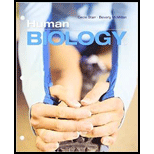
Concept explainers
To distinguish: Between neurons and nerves.
Introduction: The nervous system controls and coordinates all the activities of animals. It is classified into two major types, namely the central nervous system (CNS) and the peripheral nervous system (PNS). The CNS includes the brain and the spinal cord. The PNS includes neurons and ganglia. The primary tissue of this system is the nervous tissue.
To distinguish: Between the somatic system and the autonomic system.
Introduction: The nervous system controls and coordinates all the activities of animals. It is classified into two major types, namely the central nervous system (CNS) and the peripheral nervous system (PNS). The CNS includes the brain and the spinal cord. The PNS includes neurons and ganglia. The primary tissue of this system is the nervous tissue.
To distinguish: Between parasympathetic and sympathetic nerves.
Introduction: The autonomic nervous system is a functional division of the peripheral nervous system. It involves two autonomic neurons in the efferent pathway, namely preganglionic neurons and postganglionic neurons. The cell body of the preganglionic neurons is in the central nervous system (CNS), whereas the postganglionic neurons lie entirely outside the CNS. The autonomic nervous system is (structurally and functionally) divided into two parts, namely the sympathetic nervous system (SNS) and the parasympathetic nervous system (PSNS).
Want to see the full answer?
Check out a sample textbook solution
Chapter 13 Solutions
Bundle: Human Biology, Loose-leaf Version, 11th + MindTap Biology, 1 term (6 months) Printed Access Card
- 1. Match each vocabulary term to its best descriptor A. affinity B. efficacy C. inert D. mimic E. how drugs move through body F. how drugs bind Kd Bmax Agonist Antagonist Pharmacokinetics Pharmacodynamicsarrow_forward50 mg dose of a drug is given orally to a patient. The bioavailability of the drug is 0.2. What is the volume of distribution of the drug if the plasma concentration is 1 mg/L? Be sure to provide units.arrow_forwardDetermine Kd and Bmax from the following Scatchard plot. Make sure to include units.arrow_forward
- Choose a catecholamine neurotransmitter and describe/draw the components of the synapse important for its signaling including synthesis, packaging into vesicles, receptors, transporters/degradative enzymes. Describe 2 drugs that can act on this system.arrow_forwardThe following figure is from Caterina et al. The capsaicin receptor: a heat activated ion channel in the pain pathway. Nature, 1997. Black boxes indicate capsaicin, white circles indicate resinferatoxin. a) Which has a higher potency? b) Which is has a higher efficacy? c) What is the approximate Kd of capsaicin in uM? (you can round to the nearest power of 10)arrow_forwardWhat is the rate-limiting-step for serotonin synthesis?arrow_forward
 Medical Terminology for Health Professions, Spira...Health & NutritionISBN:9781305634350Author:Ann Ehrlich, Carol L. Schroeder, Laura Ehrlich, Katrina A. SchroederPublisher:Cengage Learning
Medical Terminology for Health Professions, Spira...Health & NutritionISBN:9781305634350Author:Ann Ehrlich, Carol L. Schroeder, Laura Ehrlich, Katrina A. SchroederPublisher:Cengage Learning Comprehensive Medical Assisting: Administrative a...NursingISBN:9781305964792Author:Wilburta Q. Lindh, Carol D. Tamparo, Barbara M. Dahl, Julie Morris, Cindy CorreaPublisher:Cengage Learning
Comprehensive Medical Assisting: Administrative a...NursingISBN:9781305964792Author:Wilburta Q. Lindh, Carol D. Tamparo, Barbara M. Dahl, Julie Morris, Cindy CorreaPublisher:Cengage Learning Human Biology (MindTap Course List)BiologyISBN:9781305112100Author:Cecie Starr, Beverly McMillanPublisher:Cengage Learning
Human Biology (MindTap Course List)BiologyISBN:9781305112100Author:Cecie Starr, Beverly McMillanPublisher:Cengage Learning Biology (MindTap Course List)BiologyISBN:9781337392938Author:Eldra Solomon, Charles Martin, Diana W. Martin, Linda R. BergPublisher:Cengage Learning
Biology (MindTap Course List)BiologyISBN:9781337392938Author:Eldra Solomon, Charles Martin, Diana W. Martin, Linda R. BergPublisher:Cengage Learning





